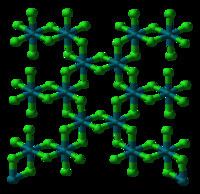Formula RhCl3 Boiling point 717 °C | Molar mass 209.26 g/mol Density 5.38 g/cm³ | |
 | ||
Related compounds Appearance dark red solid; deliquescent | ||
Rhodium(III) chloride refers to inorganic compounds with the formula RhCl3(H2O)n, where n varies from 0 to 3. These are diamagnetic solids featuring octahedral Rh(III) centres. Depending on the value of n, the material is either a dense brown solid or a soluble reddish salt. The soluble salt is widely used to prepare compounds used in homogeneous catalysis, notably for the industrial production of acetic acid.
Contents
Structures
Hydrated rhodium trichloride usually refers to compound with the approximate formula RhCl3(H2O)3. 103Rh NMR spectroscopy shows that solutions of this material consist of several species, the proportions of which change with time and depend on the concentration of chloride. The relative distribution of these species determines the colour of the solutions, which can range from yellow (the hexaaquo ion) to "raspberry-red". Some of these species are [Rh(H2O)6]3+, [RhCl(H2O)5]2+, cis- and trans-[RhCl2(H2O)4]+, and [RhCl3(H2O)3]. Individual ions have been separated by ion exchange chromatography.
Anhydrous rhodium chloride crystallises with a monoclinic crystal structure, as in YCl3 and AlCl3. It is a dense brown solid that is insoluble in common solvents and of little value in the laboratory.
Preparation
RhCl3(H2O)3 is produced from salts such as Na3RhCl6, the latter being obtained in the purification of rhodium from the other platinum group metals such as platinum and iridium. The sodium salt is converted to H3RhCl6 by ion exchange chromatography. Recrystallization of this acidic salt from water affords the hydrated trichloride, sometimes called "soluble rhodium trichloride." Anhydrous RhCl3 is prepared by reaction of chlorine with rhodium sponge metal at 200–300 °C. Above 800 °C, the anhydrous chloride reverts to Rh metal and chlorine.
Various rhodium chloride complexes are intermediates in the purification of rhodium from its ores.
Coordination complexes
RhCl3(H2O)3 is the precursor to a wide variety of complexes, some of which are commercially useful. Complexes of Rh(III) are generally kinetically inert with octahedral geometry. Rh(I) derivatives tend to adopt square planar molecular geometry or be five-coordinate.
Amines and pyridine
Solutions of RhCl3(H2O)3 react with ammonia in the presence of alcohol to give the salt pentamminerhodium chloride ([RhCl(NH3)5]Cl2). Zinc reduction of this cation followed by the addition of sulfate gives the colourless hydride complex [RhH(NH3)5]SO4.
Upon boiling in a mixture of ethanol and pyridine (py), hydrated rhodium trichloride converts to trans-[RhCl2(py)4)]Cl. The reducing influence of the ethanol is apparent because the corresponding reaction in water affords fac-RhCl3(pyridine)3, analogous to the thioether derivatives. Oxidation of aqueous ethanolic solution of pyridine and RhCl3(H2O)3 by air affords blue paramagnetic[Cl(py)4Rh-O2-Rh(py)4Cl]5+.
Thioethers and tertiary phosphines
Ethanolic solutions of hydrated rhodium trichloride react with dialkyl sulfides.
Both fac and mer stereoisomers of such compounds have been isolated.
Reaction of RhCl3(H2O)3 under mild conditions with tertiary phosphines affords adducts akin to the aforementioned thioether complexes. When these reactions are conducted in boiling ethanol solution, reduction of rhodium(III) occurs, leading to rhodium(I) derivatives such as [RhCl(PPh3)3], Wilkinson's catalyst, with oxidation of the solvent or more commonly with an excess of the phosphine:
Alkenes and carbon monoxide
Reaction of RhCl3(H2O)3 with olefins affords compounds of the type Rh2Cl2(alkene)4. With 1,5-cyclooctadiene, RhCl3(H2O)3 react in ethanol to give cyclooctadiene rhodium chloride dimer.
RhCl3(H2O)3 reacts with carbon monoxide (1 bar) to produce the dicarbonyldichloridorhodate(I) anion, [RhCl2(CO)2]−. Treatment of solid RhCl3(H2O)3 with flowing CO gives [RhCl(CO)2]2, known as rhodium carbonyl chloride.
Numerous Rh-CO-PR3 (R = organic group) compounds have been prepared in the course of extensive investigations on hydroformylation catalysis. RhCl(PPh3)3 reacts with CO to give trans-RhCl(CO)(PPh3)2, stoichiometrically analogous to but less reactive than Vaska's complex. Trans-RhCl(CO)(PPh3)2 reacts with a mixture of NaBH4 and PPh3 to give HRh(CO)(PPh3)3, a highly active catalyst for hydroformylation of alkenes.
Catalysis
Beginning especially in the 1960s, RhCl3(H2O)3 was demonstrated to be catalytically active for a variety of reactions involving CO, H2, and alkenes. For example, RhCl3(H2O)3 was shown to dimerise ethene to a mixture of cis and trans 2-butene:
2 C2H4 → CH3-CH=CH-CH3Unfortunately this reaction fails for higher alkenes.
Ethylene dimerization was shown to involve catalysis by Rh2Cl2(C2H4)4. This and many related discoveries nurtured the then young field of homogeneous catalysis, wherein the catalysts are dissolved in the medium with the substrate. Previous to this era, most metal catalysts were "heterogeneous", i.e. the catalysts were solids and the substrates were either liquid or gases. Another advance in homogeneous catalysis was the finding that PPh3-derived complexes were active catalytically as well as soluble in organic solvents. Best known of the phosphine-supported catalysts is RhCl(PPh3)3,: which catalyzes the hydrogenation and isomerization of alkenes. The hydroformylation of alkenes is catalyzed by the related RhH(CO)(PPh3)3. Catalysis by rhodium is so efficient that it has significantly displaced the previous technology based on less expensive cobalt catalysts.
Safety
Rhodium(III) chloride is not listed under Annex I of Directive 67/548/EEC, but is usually classified as harmful, R22: Harmful if swallowed. Some Rh compounds have been investigated as anti-cancer drugs. It is listed in the inventory of the Toxic Substances Control Act (TSCA).
